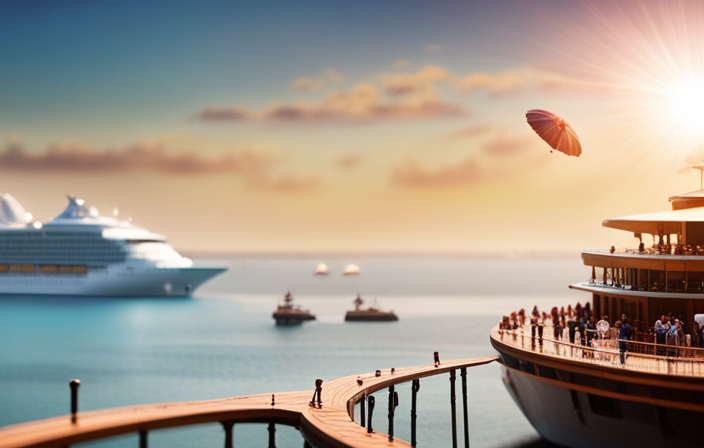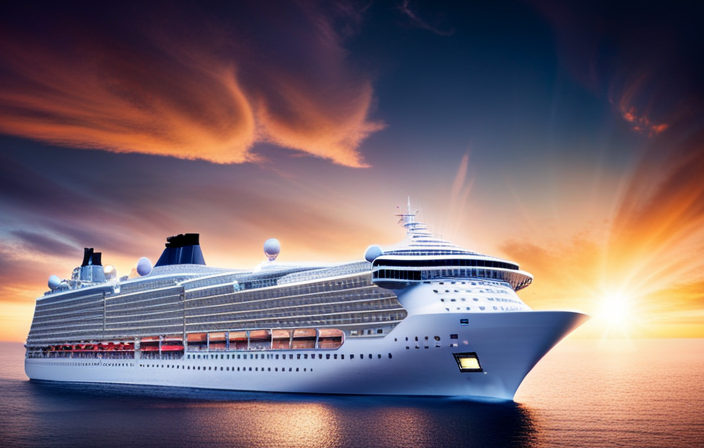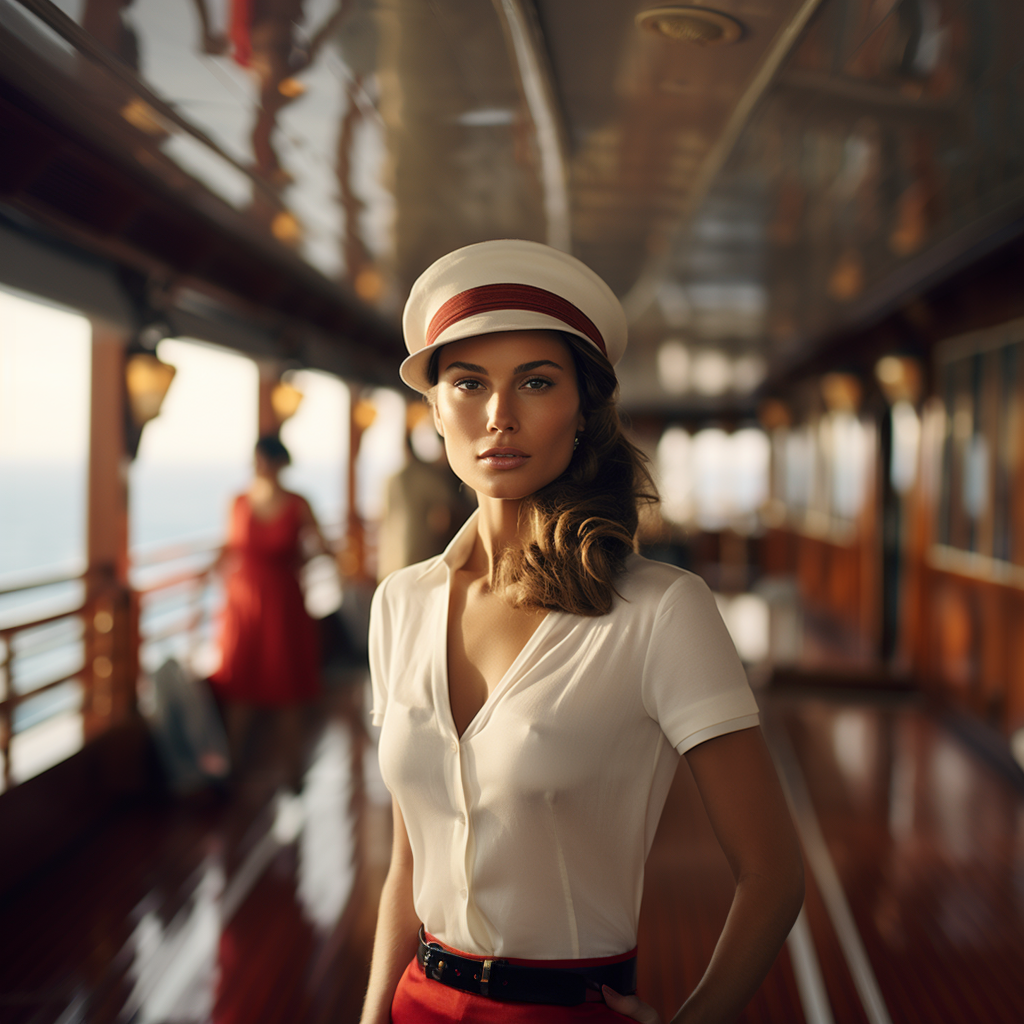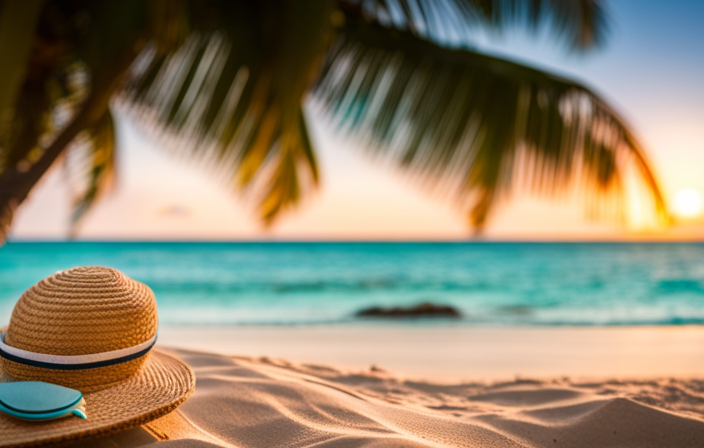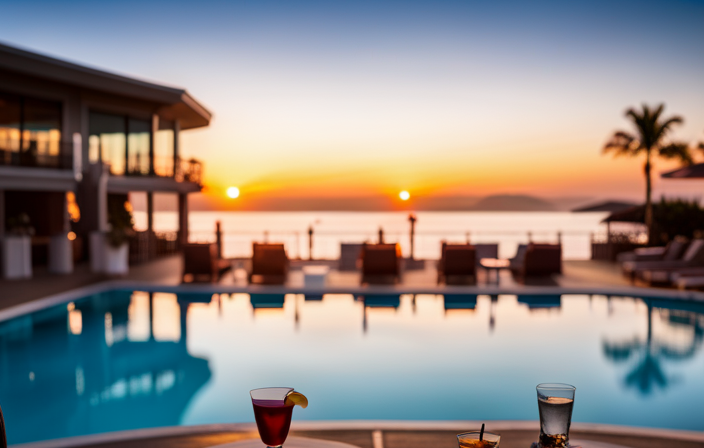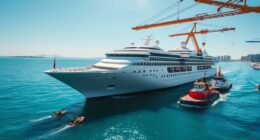Have you ever reflected on the average size of a cruise ship?
When I first stepped onboard a cruise ship, I was immediately struck by its sheer size and grandeur. It felt like a floating city, with endless corridors, multiple decks, and a multitude of amenities. But what are the actual dimensions of these floating behemoths?
In this article, we will delve into the world of cruise ships and explore their evolution in size, from the humble beginnings to the colossal vessels we see today. We will uncover the fascinating anatomy of a cruise ship, from the luxurious cabins to the expansive dining areas and entertainment venues.
But it’s not all about the big ships. We will also take a look at the growing trend of smaller, more intimate cruise ships, offering a different kind of experience for travelers. And of course, we will examine the environmental impact of these massive vessels and the measures being taken to mitigate it.
So join me as we embark on this journey to discover just how big the average cruise ship truly is and uncover the fascinating world behind these floating marvels.
Key Takeaways
- Cruise ships have evolved from small vessels to colossal floating metropolises, with the average ship now able to accommodate 3,000 to 4,000 passengers and some mega-ships accommodating over 6,000 passengers.
- The deck layouts and features of cruise ships are designed to enhance the passenger experience, with panoramic views, outdoor movie theaters, recreational activities, and water parks available.
- Cruise ship interiors offer elegance and comfort, with grand atriums, cozy lounges, spa treatments, world-class entertainment, fitness classes, and onboard casinos.
- There is a growing trend of smaller cruise ships that offer a more intimate and personalized experience, with benefits including shorter lines, unique ports and destinations, and a greater sense of camaraderie among fellow travelers.
The Evolution of Cruise Ship Sizes
If you’re picturing a massive floating city with towering decks and endless amenities, you’re not far off – the evolution of cruise ship sizes has turned these vessels into veritable floating metropolises.
The history of cruise ship sizes is a fascinating journey that showcases the industry’s commitment to innovation and passenger comfort. In the early days, cruise ships were relatively small, accommodating only a few hundred passengers. However, as demand grew and technology advanced, ships started to get bigger and better.
Today, the average cruise ship can carry around 3,000 to 4,000 passengers, with some mega-ships accommodating over 6,000 passengers. The impact of cruise ship size on the passenger experience is significant. Larger ships offer a wider range of amenities, including multiple restaurants, theaters, and even water parks. These mammoth vessels provide a diverse and immersive experience for travelers.
Moving on to the next section about the anatomy of a cruise ship, let’s explore how these floating metropolises are designed.
The Anatomy of a Cruise Ship
When it comes to cruise ships, the deck layouts and features play a crucial role in enhancing the overall experience. From expansive sun decks and swimming pools to multiple dining options and entertainment venues, these ships offer a wide range of amenities for passengers to enjoy.
Additionally, the interior spaces are thoughtfully designed to provide comfort and luxury. The cabins are spacious and elegant, providing a relaxing retreat for passengers. The lounges are also beautifully designed, offering a sophisticated atmosphere for socializing and entertainment. Furthermore, the ships are equipped with state-of-the-art facilities, ensuring that passengers have access to everything they need during their cruise.
In conclusion, the anatomy of a cruise ship includes both the exterior and interior spaces, all designed to provide passengers with a memorable and enjoyable experience.
Deck layouts and features
As you explore the deck layouts and features of the average cruise ship, you’ll be amazed by the plethora of amenities awaiting you. From the dazzling swimming pools to the luxurious spa facilities. Cruise ship deck layouts are meticulously designed to optimize space and provide a variety of entertainment options for passengers.
Modern design trends focus on creating open and airy spaces, with multiple levels and panoramic views of the ocean. You’ll find scenic promenades for strolling, spacious sun decks for lounging, and even outdoor movie theaters for enjoying a film under the stars. The deck layouts also incorporate recreational activities such as mini-golf courses, basketball courts, and water slides to keep passengers entertained throughout their voyage.
Moving beyond the deck layouts, let’s now delve into the interior spaces and amenities that await you on a cruise ship journey.
Interior spaces and amenities
The interior spaces and amenities on a cruise ship offer a diverse range of experiences for passengers to enjoy, immersing them in a world of luxury and relaxation.
The interior design of cruise ships is carefully crafted to create an atmosphere of elegance and comfort. From grand atriums to cozy lounges, every space is thoughtfully designed to enhance the overall passenger experience.
Additionally, cruise ships are equipped with a wide array of onboard activities, catering to various interests and preferences. Passengers can indulge in spa treatments, enjoy world-class entertainment, partake in fitness classes, or try their luck at the onboard casino. With so many options available, there is something for everyone to enjoy.
As we transition into discussing the largest cruise ships in the world, it’s fascinating to see how these interior spaces and amenities are scaled up to accommodate an even greater number of passengers.
The Largest Cruise Ships in the World
When it comes to cruise ships, size definitely matters. The largest cruise ships in the world are truly awe-inspiring. These mega-ships are a marvel of engineering. Their massive size and luxurious amenities make them stand out. From the Royal Caribbean’s Symphony of the Seas to the Harmony of the Seas, these behemoths are packed with features and attractions. They cater to every interest and age group. Thrilling water slides and Broadway-style shows are just a few examples.
Comparison of the biggest cruise ships
Surprisingly, even the biggest cruise ships can’t compare to the vastness of the ocean. These massive floating cities are a testament to the evolution of shipbuilding techniques and the desire to create an unforgettable passenger experience.
The sheer size of these colossal vessels allows them to house an impressive array of features and attractions. From multiple swimming pools and water slides to Broadway-style theaters and gourmet restaurants, there is something for everyone on board.
The impact of ship size on the passenger experience is undeniable. With more space, cruise lines are able to offer a wider variety of amenities and activities, ensuring that passengers never have a dull moment.
As we explore the features and attractions of these mega-ships, we will discover just how they manage to create a world of their own at sea.
Features and attractions of these mega-ships
The captivating features and attractions of these mega-ships are worth exploring. These floating cities offer an array of deck layouts and interior spaces that cater to every passenger’s desires. Expansive pools and water parks, luxury spas and fitness centers, and a plethora of activities ensure guests are never bored. The abundance of restaurants and bars cater to all culinary tastes, while the theaters and entertainment venues provide world-class shows and performances. Additionally, the mega-ships offer an array of shopping options, from high-end boutiques to duty-free outlets. With such a vast array of amenities, it’s no wonder why these ships are a popular choice for travelers seeking an all-inclusive vacation experience.
Now, let’s transition to the next section and explore the growing trend of small cruise ships.
The Growing Trend of Small Cruise Ships
I’ve always been fascinated by the idea of exploring the world on a cruise ship. Lately, I’ve been drawn to the growing trend of small cruise ships. Not only do these vessels offer a more intimate and personal experience, but they also provide a range of benefits.
With fewer passengers on board, you can expect shorter lines, more attentive service, and a greater sense of camaraderie among fellow travelers.
Additionally, small cruise ships often have the advantage of accessing unique ports and destinations that larger ships simply cannot reach. This allows for truly one-of-a-kind experiences.
Benefits of traveling on smaller vessels
Although smaller in size, traveling on these vessels offers numerous benefits. Here are three advantages of exploring the seas on a small cruise ship:
-
Intimate Atmosphere: With fewer passengers onboard, small ships provide a more intimate and relaxed environment. You can avoid the crowds and enjoy a peaceful vacation without feeling overwhelmed.
-
Personalized Experiences: Smaller vessels allow for a higher level of personalized service. The crew can cater to your individual needs and preferences, ensuring a more tailored and memorable journey.
-
Access to Unique Ports: Small ships have the advantage of accessing ports that larger cruise ships cannot reach. This opens up a world of unique destinations and hidden gems, allowing you to explore off-the-beaten-path locations and experience authentic cultures.
Traveling on smaller vessels offers a range of benefits that make for an exceptional cruise experience. From the personalized service to the ability to visit unique ports, these ships provide a truly special adventure.
Next, let’s delve into the unique experiences offered by boutique cruises.
Unique experiences offered by boutique cruises
Discover the captivating allure of boutique cruises, where you’ll be immersed in unique experiences and create lasting memories.
Did you know that boutique cruises offer an average of 10 shore excursions per voyage, allowing you to explore a variety of fascinating destinations? Unlike larger cruise ships, boutique cruise itineraries are carefully curated to provide a more intimate and immersive experience.
With smaller passenger capacity, personalized service is a priority, ensuring that every guest feels valued and attended to. From private guided tours to off-the-beaten-path destinations, boutique cruises offer a level of exclusivity that larger vessels simply cannot match.
Whether it’s exploring hidden coves, dining at local restaurants, or engaging in cultural activities, these cruises provide an unparalleled opportunity to connect with the destinations on a deeper level.
Transitioning to the subsequent section, let’s now delve into the environmental impact of cruise ships.
The Environmental Impact of Cruise Ships
Despite their immense size, the environmental impact of cruise ships cannot be ignored. These floating cities leave a significant carbon footprint, emitting large amounts of greenhouse gases into the atmosphere. In fact, a single cruise ship can emit as much sulfur dioxide as 13 million cars in a day.
Additionally, waste management is a major concern, as these ships generate massive amounts of sewage, gray water, and solid waste. While efforts have been made to improve sustainability practices, such as the use of advanced wastewater treatment systems and the implementation of recycling programs, there is still much progress to be made.
The future of cruise ship design holds promise for more eco-friendly solutions, such as the use of cleaner fuels, advanced waste management technologies, and the integration of renewable energy sources. With these advancements, the cruise industry can reduce its negative impact on the environment and create a more sustainable future.
The Future of Cruise Ship Design
The future of cruise ship design is looking surprisingly green and eco-friendly. Cruise ship companies are investing heavily in future sustainability and striving to reduce their environmental impact. Technological advancements are playing a crucial role in achieving this goal.
New ships are equipped with advanced wastewater treatment systems that ensure the safe disposal of waste. These systems are designed to effectively treat and recycle wastewater, minimizing the impact on marine ecosystems.
Innovative propulsion systems are also being developed to reduce fuel consumption and emissions. These systems utilize alternative fuels and energy sources, such as liquefied natural gas (LNG) or even hydrogen fuel cells. By adopting these technologies, cruise ships can significantly reduce their carbon footprint and contribute to a cleaner and greener future.
These advancements not only benefit the environment but also enhance the overall experience for passengers. With improved waste management and reduced emissions, passengers can enjoy cleaner air and water, creating a healthier and more enjoyable cruise experience.
As we move forward, cruise ships will continue to evolve, incorporating more sustainable practices and cutting-edge technologies. The industry is committed to finding innovative solutions that balance the desire for luxury and comfort with the need to protect the environment.
In the next section, we’ll delve into the behind-the-scenes aspects of cruise ships, including crew quarters and facilities, giving you a glimpse into the unseen side of these magnificent vessels.
Behind the Scenes: Crew Quarters and Facilities
When it comes to cruise ship design, one aspect that often gets overlooked is the living conditions for the staff members who work tirelessly behind the scenes.
As a crew member myself, I can attest to the fact that cruise lines are making significant improvements in this area. Not only are crew quarters becoming more spacious and comfortable, but there are also a wide range of facilities and services available to ensure the well-being and satisfaction of crew members.
Living conditions for cruise ship staff
The cruise ship staff enjoy comfortable living conditions on board. Despite the limited space, crew accommodations are well-designed to provide a comfortable and functional living space. Here are some key features:
-
Cozy cabins: Each crew member has their own cabin equipped with essential amenities such as a bed, storage space, and a private bathroom.
-
Recreation areas: There are designated spaces for crew members to relax and unwind during their free time, including lounges, gyms, and outdoor areas.
-
Dining options: The staff has access to a variety of dining options, including dedicated crew mess halls that serve a wide range of cuisines.
-
Laundry facilities: Onboard laundry facilities are available to ensure that the crew members have clean clothes throughout their stay.
-
Internet access: Wi-Fi is provided for the staff, allowing them to stay connected with their loved ones back home.
With these comfortable living conditions, cruise ship staff can enjoy a good work-life balance.
Moving on to the next section, let’s explore the facilities and services available for crew members.
Facilities and services for crew members
Get ready to discover the fantastic facilities and services available exclusively for the hardworking crew members on board!
Cruise ship companies understand the importance of providing comfortable accommodations for their crew members. Many ships have dedicated crew member areas that include cabins with bunk beds, private bathrooms, and a small sitting area. These accommodations ensure that crew members have a space to relax and rest after a long day of work.
Additionally, crew members are also provided with a variety of dining options. They have access to crew-only dining areas that offer a range of delicious meals, catering to different tastes and dietary preferences. This helps to ensure that crew members are well-nourished and energized to perform their duties.
The facilities and dining options provided to crew members are an essential part of creating a positive working environment on board.
Moving on to the economic impact of the cruise industry, it is evident that…
The Economic Impact of the Cruise Industry
The economic impact of the cruise industry is substantial, driving economic growth and creating numerous job opportunities. According to a study conducted by the Cruise Lines International Association (CLIA), the global cruise industry generated $150 billion in economic output in 2018, supporting over 1.1 million jobs worldwide.
This includes both direct employment on cruise ships and indirect employment in related industries such as tourism, hospitality, and manufacturing.
Additionally, the cruise industry stimulates local economies by bringing tourists to various destinations, who then spend money on accommodations, dining, shopping, and other activities. The economic benefits extend beyond the cruise lines themselves, positively impacting ports, local businesses, and communities around the world.
As we transition to the next section about safety and security measures on cruise ships, it is important to recognize the significant economic contributions of this booming industry.
Safety and Security Measures on Cruise Ships
When it comes to safety and security on cruise ships, two key areas that deserve attention are emergency procedures and drills, as well as security systems and protocols.
Emergency procedures and drills are essential for ensuring that both crew members and passengers are prepared for any potential emergencies that may arise while onboard. These procedures include instructions on how to respond to fires, medical emergencies, and other critical situations. Regular drills are conducted to familiarize everyone with these procedures and ensure that they can be executed efficiently.
Additionally, robust security systems and protocols are crucial for maintaining a safe environment and preventing any security threats or incidents. Cruise ships are equipped with surveillance cameras, access control systems, and alarms to monitor and control access to different areas of the ship. Security personnel are also trained to handle potential threats and ensure the safety of passengers and crew members.
By focusing on these aspects, the cruise industry can continue to provide a secure and enjoyable experience for all passengers. These safety and security measures are implemented to mitigate risks and ensure that everyone can relax and enjoy their time on board without worrying about their well-being.
Emergency procedures and drills
During emergency drills, passengers are thrust into chaotic scenarios, forcing them to confront the terrifying reality of potential onboard disasters aboard a cruise ship. These drills are crucial for preparing passengers for emergency response and evacuation procedures.
Cruise ships are equipped with state-of-the-art emergency systems to ensure the safety of passengers and crew members. These systems include alarm systems, lifeboats, and evacuation slides. Passengers are instructed on how to locate their designated muster stations and the procedures to follow in case of an emergency.
Crew members play a vital role in guiding and assisting passengers during these drills, ensuring that everyone is aware of the emergency protocols. It is reassuring to know that cruise ships prioritize the safety of their passengers by conducting regular drills and implementing effective emergency procedures.
Transitioning into the next section about security systems and protocols, it is equally important to understand the measures in place to keep passengers safe throughout their journey.
Security systems and protocols
Rest assured, your safety is of utmost importance. That’s why state-of-the-art security systems and protocols are in place to protect you throughout your journey on a cruise ship.
These security measures are designed to ensure a safe and secure environment for all passengers and crew members. Cruise ships are equipped with cutting-edge technology, including advanced surveillance systems and access control systems. These systems work together to detect and prevent any potential security threats.
In addition to these security systems, emergency preparedness is a top priority. Regular drills and training programs are conducted for crew members to handle different scenarios. These protocols are in place to ensure that everyone on board is well-prepared and knows what to do in case of an emergency.
Now, let’s move on to some tips for choosing the right cruise ship.
Tips for Choosing the Right Cruise Ship
When it comes to choosing the right cruise ship, there are several factors that I consider.
First and foremost, I take into account my personal preferences and what I want to get out of the cruise experience. Whether it’s a large ship with a wide range of amenities or a smaller, more intimate vessel, finding the right fit is crucial.
Additionally, I look at the size of the ship and the amenities it offers, ensuring that they align with my interests and desires for the trip.
Overall, selecting the perfect cruise ship involves carefully considering these factors to ensure an enjoyable and fulfilling vacation.
Factors to consider when selecting a cruise
To make the most of your cruise experience, keep in mind the factors you should consider when choosing the perfect voyage. Here are three important factors to consider when selecting a cruise:
-
Destination: Think about where you want to go and what you want to see. Consider if you prefer tropical beaches, historical cities, or scenic landscapes. The right destination will ensure you have a memorable experience.
-
Ship Size: While larger cruise ships offer more amenities and entertainment options, smaller vessels have their own benefits. They can access ports that larger ships can’t, offering a more intimate and immersive experience.
-
Personal Preferences: Consider your travel style and what you value most in a cruise. Do you prefer a laid-back atmosphere or a lively party scene? Are you interested in cultural enrichment or outdoor adventures? Matching ship size and amenities to your personal preferences will ensure you have a cruise that suits your needs.
By considering these factors, you can find the perfect cruise that matches your preferences and provides an unforgettable experience.
Matching ship size and amenities to personal preferences
For a truly tailored cruise experience, it’s all about finding the perfect match between your personal preferences and the size and amenities of the vessel.
When considering the size of a cruise ship, there are benefits of both large and small ships. Large ships often offer a wide range of amenities and activities, such as multiple dining options, theaters, and even water parks. This can be appealing to those who enjoy having a variety of options and entertainment at their fingertips.
On the other hand, small ships tend to have a more intimate atmosphere and can offer a more personalized experience. They often have fewer passengers, allowing for a more relaxed and less crowded environment. However, it’s important to note that smaller ships may have limited amenities and entertainment options compared to their larger counterparts.
Ultimately, the decision between a large or small ship will depend on your personal preferences and what you value most in a cruise experience.
Frequently Asked Questions
How much does it cost to build a cruise ship?
Building a cruise ship involves a complex cost breakdown and can take several years. The construction timeline includes designing, engineering, and outfitting the vessel. The total cost varies based on size, amenities, and customization.
What is the average passenger capacity of a cruise ship?
The average passenger capacity of a cruise ship is around 2,500 people. This demographic varies depending on the cruise line and destination. The impact of cruise ship tourism on local economies can be significant, boosting tourism, employment, and revenue.
How many crew members are typically employed on a cruise ship?
Typically, cruise ships employ around 1,000 crew members. With high crew member turnover, they handle various responsibilities like guest services, housekeeping, entertainment, and maintenance, ensuring a smooth and enjoyable experience for passengers.
What are the most popular destinations for cruise ships?
The top rated cruise ship companies offer an array of must visit ports of call for passengers. Some popular destinations include the Caribbean, Mediterranean, Alaska, and the Bahamas, each offering unique experiences and breathtaking scenery.
How long does it take to construct a cruise ship?
Constructing a cruise ship is no small feat. It takes years to complete the shipbuilding process, with an average construction time of around 2-3 years. From designing to building, it’s a meticulous and time-consuming endeavor.
Can the Size of a Cruise Ship be Determined by the Number of Stories it Has?
The size of a cruise ship cannot be accurately determined by the number of cruise ship stories alone. Other factors such as length, width, and displacement also play a crucial role in determining the overall size and capacity of a cruise ship. The number of cruise ship stories is just one aspect of its overall size.
Conclusion
In conclusion, the world of cruise ships is vast and ever-evolving. From the massive behemoths that dominate the seas to the small and intimate vessels that offer a unique experience, there is a cruise ship for every type of traveler.
However, it is important to remember that size does not always equate to quality or enjoyment. As the saying goes, "It’s not the size of the ship, but the motion of the ocean." So when choosing a cruise ship, consider not only its size but also its amenities, itineraries, and overall experience.
Happy sailing!
Meet Asra, a talented and adventurous writer who infuses her passion for exploration into every word she writes. Asra’s love for storytelling and her insatiable curiosity about the world make her an invaluable asset to the Voyager Info team.
From a young age, Asra was drawn to the power of words and their ability to transport readers to far-off lands and magical realms. Her fascination with travel and cultures from around the globe fueled her desire to become a travel writer, and she set out on a journey to turn her dreams into reality.

